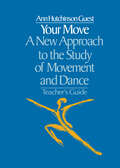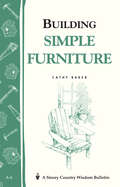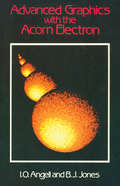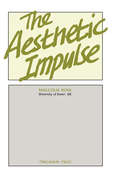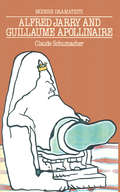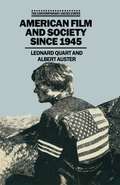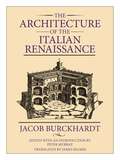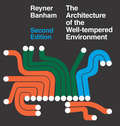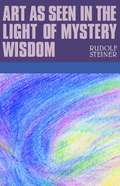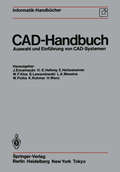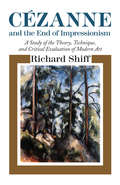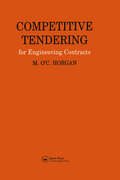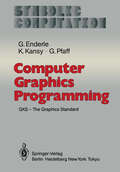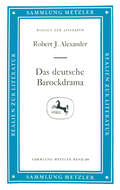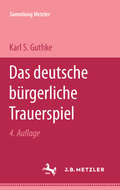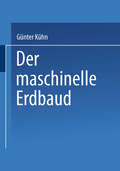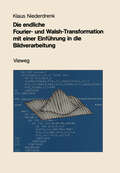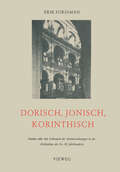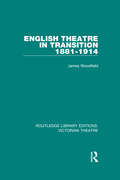- Table View
- List View
Your Move: A New Approach to the Study of Movement and Dance
by Ann Hutchinson GuestYour Move: A New Approach to the Study of Movement and Dance establishes a fresh and original framework for looking at dance. In examining the basic elements of dance - the Alphabet of Movement - and using illustrations of movement technique and notation symbols it provides a new way to see, to teach and to choreograph dance. This book gives a list of primary actions upon which all physical activity is gased, focusing on both the functional and expressive sides of movement. It draws upon the author's broad experience in ballet, modern and ethnic dance to reinterpret movement and to shed new light on the role of movement in dance. Your Move is an important book not only for dancers but also for instructors in sport and physical therapy. Each copy of Your Move comes complete with exercise sheets, which can also be purchased separately. A teacher's guide has also been designed providing notes on each chapter, approaches to the exploration of movement, interpretation of the reading studies, additional information of motif description and answers to the exercise sheets. An optional audio cassette, with music written and recorded especially for use with the book, is also available.
Building Simple Furniture: Storey Country Wisdom Bulletin A-06 (Storey Country Wisdom Bulletin)
by Cathy BakerEASY-TO-BUILD PROJECTS FOR THE WEEKEND WOODWORKER!Look over the variety of simple wood-working projects in the bulletin and you’ll quickly find something that deserves a place in your home. A small table for the hallway, perhaps, or an Adirondack chair or picnic set for the deck or garden? The good news is that you don’t need to be a master carpenter with a basement full of power tools to craft these handsome and practical items. With a few simple hand tools and Cathy Baker’s step-by-step instructions and easy-to-follow illustrations and diagrams, you can build sturdy, durable, beautiful wooden furniture that you and your family will enjoy for years to come. Projects include:· Wall shelf· Small bench· Picnic table and benches· Adirondack chair· Pump lamp· Step stool· Storage box· Side table
The Aesthetic Impulse
by Malcolm RossThe Aesthetic Impulse explains aesthetic as describing a significant area of the school curriculum that would include but not be confined to the creative arts. Organized into 10 chapters, this book begins with a discussion on arts education. Subsequent chapters explain art, sensibility, aesthetics, and the vernacular principle. The concept of arts education as cultural education, which means responding to the young's needs to generate individual and group identity, is also described. Other chapters explore the aesthetic curriculum and assessment of aesthetic development.
The Architecture of the Italian Renaissance (World Of Art Ser.)
by Jacob Burckhardt"There may not be any book on architecture so delightful to dip into; one wishes there were a pocket edition to take on an Italian vacation—not only for its information and vision but for such pleasant reminders as that the citizens of Treviso carried Tullio Lombardo's friezes through the town in triumph before they were attached to a building."—D. J. R. Bruckner, New York Times Book Review
Architecture of the Well-Tempered Environment
by Reyner BanhamReyner Banham was a pioneer in arguing that technology, human needs, and environmental concerns must be considered an integral part of architecture. No historian before him had so systematically explored the impact of environmental engineering on the design of buildings and on the minds of architects. In this revision of his classic work, Banham has added considerable new material on the use of energy, particularly solar energy, in human environments. Included in the new material are discussions of Indian pueblos and solar architecture, the Centre Pompidou and other high-tech buildings, and the environmental wisdom of many current architectural vernaculars.
Architecture of the Well-Tempered Environment
by Reyner BanhamReyner Banham was a pioneer in arguing that technology, human needs, and environmental concerns must be considered an integral part of architecture. No historian before him had so systematically explored the impact of environmental engineering on the design of buildings and on the minds of architects. In this revision of his classic work, Banham has added considerable new material on the use of energy, particularly solar energy, in human environments. Included in the new material are discussions of Indian pueblos and solar architecture, the Centre Pompidou and other high-tech buildings, and the environmental wisdom of many current architectural vernaculars.
Art as Seen in the Light of Mystery Wisdom: Eight Lectures Given In Dornach Between 28 Decemer 1914 And 4 January 1915
by Rudolf SteinerWithin the Mystery cultures of ancient history, art, science and religion formed a unity that offered direction and spiritual nourishment to the broader society. Today, art, science and religion can again be reunited. However, as Marie Steiner indicates in her introduction to these lectures, these aspects of our culture need rejuvenation through fresh spiritual understanding and knowledge. Art cannot be renewed through compromise, but only by returning to the spiritual foundations of life. As she says: "The remedy lies in unlocking the wisdom of the Mysteries and presenting it to humanity in a form adapted to contemporary needs." In these wide-ranging lectures, Rudolf Steiner offers spiritual insight for the modern day into a revitalised world of the arts. His themes include: the relation of art to technology, the moral experience of the worlds of colour and music, the legendary Norwegian Dream Song of Olaf Åsteson, and the relationship between the various arts of architecture, sculpture, painting, music, poetry, eurythmy and the human being.
CAD-Handbuch: Auswahl und Einführung von CAD-Systemen (Informatik-Handbücher)
by J. Encarnacao H. E. Hellwig E. Hettesheimer W. F. Klos S. Lewandowski L. A. Messina W. Poths K. Rohmer H. WenzCezanne and the End of Impressionism: A Study of the Theory, Technique, and Critical Evaluation of Modern Art
by Richard ShiffDrawing on a broad foundation in the history of nineteenth-century French art, Richard Shiff offers an innovative interpretation of Cézanne's painting. He shows how Cézanne's style met the emerging criteria of a "technique of originality" and how it satisfied critics sympathetic to symbolism as well as to impressionism. Expanding his study of the interaction of Cézanne and his critics, Shiff considers the problem of modern art in general. He locates the core of modernism in a dialectic of making (technique) and finding (originality). Ultimately, Shiff provides not only clarifying accounts of impressionism and symbolism but of a modern classicism as well.
Cezanne and the End of Impressionism: A Study of the Theory, Technique, and Critical Evaluation of Modern Art
by Richard ShiffDrawing on a broad foundation in the history of nineteenth-century French art, Richard Shiff offers an innovative interpretation of Cézanne's painting. He shows how Cézanne's style met the emerging criteria of a "technique of originality" and how it satisfied critics sympathetic to symbolism as well as to impressionism. Expanding his study of the interaction of Cézanne and his critics, Shiff considers the problem of modern art in general. He locates the core of modernism in a dialectic of making (technique) and finding (originality). Ultimately, Shiff provides not only clarifying accounts of impressionism and symbolism but of a modern classicism as well.
Cezanne and the End of Impressionism: A Study of the Theory, Technique, and Critical Evaluation of Modern Art
by Richard ShiffDrawing on a broad foundation in the history of nineteenth-century French art, Richard Shiff offers an innovative interpretation of Cézanne's painting. He shows how Cézanne's style met the emerging criteria of a "technique of originality" and how it satisfied critics sympathetic to symbolism as well as to impressionism. Expanding his study of the interaction of Cézanne and his critics, Shiff considers the problem of modern art in general. He locates the core of modernism in a dialectic of making (technique) and finding (originality). Ultimately, Shiff provides not only clarifying accounts of impressionism and symbolism but of a modern classicism as well.
Cezanne and the End of Impressionism: A Study of the Theory, Technique, and Critical Evaluation of Modern Art
by Richard ShiffDrawing on a broad foundation in the history of nineteenth-century French art, Richard Shiff offers an innovative interpretation of Cézanne's painting. He shows how Cézanne's style met the emerging criteria of a "technique of originality" and how it satisfied critics sympathetic to symbolism as well as to impressionism. Expanding his study of the interaction of Cézanne and his critics, Shiff considers the problem of modern art in general. He locates the core of modernism in a dialectic of making (technique) and finding (originality). Ultimately, Shiff provides not only clarifying accounts of impressionism and symbolism but of a modern classicism as well.
Competitive Tend Engin Cont
by MO HorganFirst published in 1984. Routledge is an imprint of Taylor & Francis, an informa company.
Competitive Tend Engin Cont
by MO HorganFirst published in 1984. Routledge is an imprint of Taylor & Francis, an informa company.
Computer Graphics Programming: GKS — The Graphics Standard (Symbolic Computation)
by G. Enderle K. Kansy G. PfaffFor several years the authors of this book have been involved in the design and the national and international review of the forthcoming graphical standard. When the end of this process could be foreseen and the International Standard "Graphical Kernel System" (GKS) was cast into its. final form, the urgent need arose for detailed information to the graphics community about this stan dard and for the education of graphics programmers. One major goal of GKS, besides the portability of graphical application programs and the device inde pendence, is "programmer portability" by establishing a common base for train ing of graphics programmers. Having accompanied the path of GKS from the very early stages of defining the basic concepts and designing its first versions up to the final draft of the International Standard, we feIt it worthwhile to start the venture of a text book on computer graphics programming based on GKS. This book is aimed, at one hand, at graphics users, experts and managers who want to get an overview of the new standard and a better understanding of its concepts. On the other hand, it addresses the graphics programmers who want to use GKS for realizing their graphical applications. It can serve as the base for teaching and studying functions, concepts and methods of GKS. Addi tionally, it will be a valuable source of information for implementors of GKS.
Die endliche Fourier- und Walsh-Transformation mit einer Einführung in die Bildverarbeitung: Eine anwendungsorientierte Darstellung mit FORTRAN 77-Programmen
by Klaus NiederdrenkDorisch, Jonisch, Korinthisch: Studien über den Gebrauch der Säulenordnungen in der Architektur des 16.–18. Jahrhunderts
by Erik ForssmanEnglish Theatre in Transition 1881-1914 (Routledge Library Editions: Victorian Theatre)
by James WoodfieldOriginally published in 1984. The turn of the nineteenth and twentieth centuries was a time of considerable change in the English theatre. Victorian attitudes were shocked or shattered by the new drama of Ibsen; the major figure of George Bernard Shaw dominated the period; theatre censorship was the subject of a long and furious contest; and staging conventions changed from the spectacular stylings of Irving and Beerbohm Tree to the masking and statuesque styles of Isadora Duncan and the inner realism of Stanislavsky. This book traces the activities of the leading figures in the English theatre, notably William Archer who introduced Ibsen to this country and who became one of the main promoters of the idea of a National Theatre. Other personalities discussed include Harley Granville Barker, particularly his association with Shaw at the Court Theatre and his part in campaigns against censorship and for changes in the staging of Shakespeare, and Edward Gordon Craig, whose rebellion against the Victorian theatre took and anti-realist direction. This is a stimulating account of the background to the modern English theatre which can only increase appreciation of its standard and variety.
English Theatre in Transition 1881-1914 (Routledge Library Editions: Victorian Theatre)
by James WoodfieldOriginally published in 1984. The turn of the nineteenth and twentieth centuries was a time of considerable change in the English theatre. Victorian attitudes were shocked or shattered by the new drama of Ibsen; the major figure of George Bernard Shaw dominated the period; theatre censorship was the subject of a long and furious contest; and staging conventions changed from the spectacular stylings of Irving and Beerbohm Tree to the masking and statuesque styles of Isadora Duncan and the inner realism of Stanislavsky. This book traces the activities of the leading figures in the English theatre, notably William Archer who introduced Ibsen to this country and who became one of the main promoters of the idea of a National Theatre. Other personalities discussed include Harley Granville Barker, particularly his association with Shaw at the Court Theatre and his part in campaigns against censorship and for changes in the staging of Shakespeare, and Edward Gordon Craig, whose rebellion against the Victorian theatre took and anti-realist direction. This is a stimulating account of the background to the modern English theatre which can only increase appreciation of its standard and variety.
